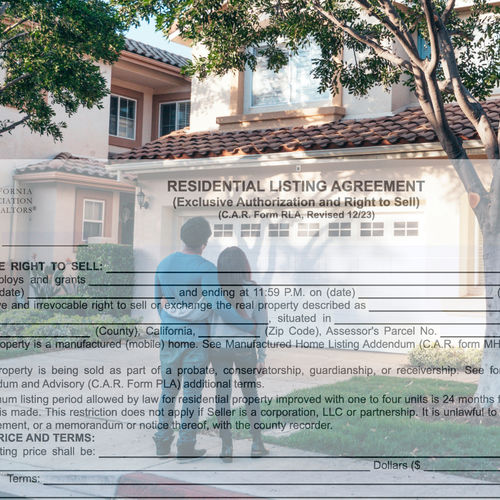The Silicon Valley real estate market can be an unpredictable beast. One day, your home might be the hot new property on the block, and a few days later, you and every buyer out there are wondering why it hasn’t sold yet. If you’re a homeowner working to sell your Silicon Valley home that’s been on the market a while, you might have considered reducing your listing price. But when is the right time to make this move? How do you know if a price reduction is necessary or if you should hold out for an offer at or at least really close to what you’re asking right now? In this article, I delve into these questions and tell you everything you need to know about reducing the price of your Silicon Valley listing – and more.
How to Sell without Ever Reducing your Price
I’m not going to sugarcoat this: you will get a lot more money for your home if you never need to reduce your price. My real estate brokerage, Compass, has looked at how much it costs a seller to need to reduce the list price. According to their data, Bay Area homes that had even one price reduction sell for an average of 8-10% per less per square foot than homes which required no price reduction to sell.
It’s not hard to do the math: if the average price per square foot for homes is your neighborhood is $1,000 and your home is 1,500 square feet and even one price reduction is going to cost you 10% per square foot – this means that needing even one price reduction will, statistically, cost you about $150,000. That’s expensive.
My advice is simple: don’t become that kind of statistic. Regardless of where your home is, how big or small, how new or old, in move-in ready condition or in rough shape, the best idea is to underprice your home right from the get-go, attract multiple offers, have a bidding war, and get your REALTOR to negotiate the best price and terms possible for you that the market will bear. This is certainly, without a doubt, the way to get the absolute highest price possible for your home.
But what if, for whatever reason, this isn’t what you’ve done? Or if that’s what you thought you were doing, but nevertheless, your home still has not sold? In you are in that situation, reading this article will be very helpful for you.
Alternatives to a Price Reduction
Before considering doing a price reduction, many homeowners will, quite reasonably, ask themselves (and their REALTOR) what else can be done to get in a great full price offer, at the current list price. Here are some things you can try before you reduce the price – although, to be honest, these are things you should do before you let even one buyer in your door:
Improve Ease of Access
Some homes are very hard to show – and if your home is hard to show, it’s going to be hard to sell, almost regardless of the price you’re asking for it. I strongly recommend that you vacate your home before you put it on the market, install a lockbox, and let buyers come at any time that is convenient for them. That is the ideal, and the further your “showing instructions” are from the ideal means that you’ll probably be looking at getting a lower price.
Kick the Tenants Out
If you are selling a home with tenants in place, you are almost for sure going to be selling your home for less than if the home were vacant. That may not be true for apartment buildings (unless the leases are far below fair market rent), and it may not be as true for multi-family properties. But for single family homes, condominiums, and townhomes, that is certainly the case. You will almost for sure get get tens of thousands of dollars less for your home if you sell it with the tenants in place.
Improve the Screen Appeal
The MLS systems in the Bay Area all require that you have at least one photograph of your home to be on the Multiple Listing Service. In fact, there is a strong argument to be made that you should have only one photograph of your property to meet that requirement of the MLS systems. But regardless of how many photographs you have of your home on the MLS, realize that there is only one first photo buyers will see – so make sure that is a good one. Really good. Buyers will look at the location, the price, and then that first photo and often decide, based only on those three things, if it’s a property they want to go and see in person.
Usually, that first photo is an exterior shot of the front of your home. That may mean that you need to do some exterior work – landscaping, perhaps painting the front door and/or trim – I haven’t seen your home, so at this point I couldn’t make any specific recommendations about what might need to be done to make sure that your first photo is outstanding. But making that photo look its best is often key to getting buyers in your door, creating the chance for them to fall in love with it.
Get Rid of your Stuff
One of my favorite adages is, “buyer’s won’t pay for what they can’t see.” If all your stuff is getting in the way of buyers seeing your house – or rather, seeing individual spaces in your house – they are not likely to see as much value there as they would if the spaces appeared to be larger and more useful. Take my advice: get rid of as much of your stuff as possible before you have people come to see your home. After all, that’s what you want – you want them to see your home, which you’re selling, and not your stuff, which you’re not.
Take a Whiff
The sense of smell is the strongest sense in terms of the emotional responses it will generate in a person. You really want to make sure that your buyers do not have any negative memories tied to what they smell when they visit your home, as that will repel them on a gut level. Gut level reactions are much more powerful than any rational reasoning they would use to determine if or how much to offer on your home. If your home has any kind of odor that is in any way unpleasant, you really need to do everything you can to get rid of those smells. I cannot stress how important this is!
Unpleasant odors will turn off buyers, and whatever buyers who might still be interested will offer less because they themselves will not fell as good about the home, and crucially, because there will be less competition – it’s as simple as that. If your home has the faintest whiff of smells like tobacco, pet urine, mold, or even heavy cooking smells you will be well-advised to get rid of them (not just mask or cover them up with Febreze or other perfumes) before getting buyers in your door. If you need ideas for getting rid of odors in your home, here is something that might help.
Realizing the Need to Reduce your Price
To help realize that you need to reduce your price, I recommend you come at the problem from another perspective first. Let’s say that you list your home for sale, and on Day 1, you receive 10 offers, and all the offers you receive are over asking price. Would you agree that it’s fair to say that this would mean that the listing price you set for your home is below fair market value? I think most reasonable people would agree that’s true.
Now, let’s look at the opposite scenario. Imagine that your home has been on the market for a year or two, and you’ve never reduced the price, or maybe you have, but it’s been at the current price for some time. Maybe you got an offer or two or ten, but they were never close enough to the price you feel your home is worth. Or maybe you didn’t get any offers at all. You’ve tried everything else you can think of to get it sold…you carefully prepared it for sale. You decluttered. You made repairs. You staged your home. You took great photographs. You had plenty of open houses. Yet, months (or maybe years) later, your home is still on the market. If you’ve tried everything, and your home still hasn’t sold, wouldn’t it be fair to say the problem might be that the price you’re demanding is just too high?
There are few things that are more painful than having your home on the market for many weeks, months, or even years. It’s just not a lot of fun to have to live in a perpetual state of trying to get a house sold. There’s the uncertainty of when or if your house will sell, and how much cash you’ll walk away with at closing. There’s the cost of maintaining a home which you no longer wish to own – the mortgager, property tax, insurance, and upkeep. There’s the hassle of having strangers in your home during showings and open houses, intruding on your privacy. Having it take a long time to get your house sold just isn’t any fun.
Early Indicators you Need a Price Reduction
While it may be obvious after many weeks, months, or even years of trying to sell a home…and trying everything else you can think of to get the home sold…that your home is overpriced, it is usually less obvious that your home is overpriced soon after you come on market…or even before you go on market.
Yet, it is really when your home is new on the market that, statistically, you have the best chance of selling your home for the highest price the market will bear (and that’s what you expected when you put your home on the market, right?).
Having your home sit on the market for a long time means that you’ll probably end up selling for less – usually, a lot less. So it’s important to identify early on in the marketing process that you need to reduce your listing price, because the longer you wait, the more it’s likely to cost you. So what signs should you be looking for early in the process that you need to reduce the price on your Bay Area home?
Open House Attendance
When it comes to getting your home sold for the highest price, you need to understand that you need to get buyers in your door, as soon as possible. One great way to get a lot of buyers in your door as soon as possible is to have an open house – or several open houses.
But what happens if you have an open house, and nobody comes? Or if you have an open house, and traffic is really low? The amount of traffic you’ll receive at an open house can vary from place to place and will be dependent to some extent on the price range of the home. So there is no “golden formula” that can tell you how much traffic is “not enough” at your open houses. But for most neighborhoods and price points in the Bay Area, any fewer than about 8 parties through each day of an open house should be considered a sign that the market feels your price is unattractive.
Private Showings
While I am personally a big fan of using open houses to get buyers in the door quickly, there’s no denying that a good percentage of people coming through the door of your open house aren’t real buyers – they’re neighbors, or they’re lookie-loos, or tire kickers and they are not really in the market to buy any home, much less your home.
On the other hand, people who arrange to see your home on a private showing, with either the listing agent or the buyer’s agent, have a much higher level of intent to buy than people who come through an open house. Therefore, pay close attention to the number of private showings you’re getting. The more open houses that you have will reduce the number of private showings, of course. So for the sake of discussion, let’s say you don’t plan on having any open houses, how many private showings would indicate that you have the home priced right?
A good rule of thumb is that after the first week on market, you should be receiving about one showing per day, on average. You may see a lot more activity than that the first week, but by the second week, and every week thereafter, you should continue to receive about one showing per day – and if you are receiving fewer showings than that, it’s a good indication the price is too high, and should be reduced.
But what if you are doing open houses, how many private showings should you see then? Again, there’s no strict formula there either, but I figure that every three groups through an open house is the equivalent of one private showing.
That means if you have one open house in a week and nine parties come through, you should expect that there would be an additional 4 private showings that week, and would mean you’ve had the equivalent of 7 private showings for that week in total. If you’re getting less than that, it’s a pretty good indication, in my opinion, that you should be considering an immediate price reduction.
Few “saves” on Real Estate portals
One great way to see how the buying public perceives the price of your home is how many “saves” and “favorites” you are getting on the real estate portals like Zillow and Redfin. This will again vary from place to place and be dependent to some extent on the number of buyers looking in your home’s price range. But when your home first comes on the market, you should expect that you will have dozens of saves on Zillow each day for at least the first week…and if you don’t, that’s a sign your price is probably too high.
Few Requests to See the Disclosure Package
Buyers who are interested in your home will often request to see the disclosure package. Many REALTORs just hand out disclosure packages to anyone, willy-nillly. I personally don’t do that, for a number of reasons. The disclosure packages often contain private information about your home that you don’t necessarily want disseminated to just anyone. I have a policy of only giving disclosure packages only to buyers who have come to the home personally to see it.
This way, I have a good idea of who is really a serious buyer: if, after seeing a home in person, a buyer requests a disclosure package, that buyer is at least contemplating making an offer on it. On the other hand, if buyers come through your house and don’t ask to see a disclosure package, it means that they have very little or no interest in making an offer. If that’s the case, it is certainly a sign that your home is priced too high and a reduction is in order.
Higher Average Days on Market than Similar Homes which are Selling
It’s really important to keep a keen eye on the days on market for homes that are selling – and if your home is taking (much) longer than that to go under contract, it’s a good indication you need to do a price reduction.
One big mistake that REALTORs and sellers make is that they look at the wrong number for “days on market.” Often times, they will look at closed sales in the same zip code as your home – and that’s a big mistake. Looking at the “days on market” for closed sales is information that’s too old. You need something closer to real-time data, to see what the market is doing right now. Also, looking at all the homes in your zip code is too general – because the buyer for your home is not buying just any home, they are probably in the market for a home that is pretty similar to yours, specifically.
My suggestion is to look at pending sales for homes that are like yours in your market area, not just in your zip code. Your “market area” is the area in which your most-likely buyer would consider making a purchase – and that usually isn’t just limited to one specific neighborhood or zip code. Be honest about where your most-likely buyer would also consider buying a home – that’s your “market area.” Then look for homes that are generally similar to yours in terms of square footage and bedroom count, and possibly lot size – and which are priced with 20% of your home’s list price.
Take a look at those pending sales – ideally the homes which have just gone pending. These are the homes that someone preferred to buy instead of yours. Now see how many “days on market” those homes had before the seller accepted an offer. This number is typically much lower than the average “days on market” for closed homes in your zip code.
When your “days on market” exceeds the average for these similar homes which are going under contract, that is certainly a warning sign that your home is priced too high and you need to consider doing a price reduction.
How Much should you Reduce your Price?
If you have reached the conclusion that you need to reduce the price of your home in the Bay Area, the next question is: how much should you reduce it by?
There’s a little bit of good news here: even a price reduction of $1 will help you get your home sold. That’s because reducing the price by $1 will cause your listing to be refreshed in the feeds of buyers who have been keeping an eye on it. The portals will mark it as “price reduced.” It sends a message to the marketplace that you’re aware of the need to reduce the price at least somewhat.
Of course a $1 price reduction is nowhere near as good as a price reduction of $10,000 – or $100,000. But any reduction is absolutely better than no reduction whatsoever.
Many people will tell you that any price reduction needs to be “significant” in order for it to be effective. What’s significant? Common wisdom holds that anything less than a 5% reduction is not significant, and a good reduction would be in the range of 5-15% of the current list price.
However, I don’t look at it quite that way. My recommendation is to consider how buyers actually look for homes: they search for homes in ranges of prices. For example, for prices under $800,000 buyers typically search in ranges of $50K: $650K and less, $700K and less, $750K and less, etc. For prices over $800K, buyers tend to search in $100K ranges: so they will search between $1,2000,000 and $1,500,000 or say between $1,300,000 and $1,700,000.
For example, reducing your price from $1,775,000 to $1,725,000 will not get you anywhere near as much new activity on your home as will a reduction down to the next-lowest range, which in this case would be a drop to $1,700,000. This will allow your house to be found by buyers with a maximum price of $1,700,000 – whereas it will remain totally invisible to those buyers if your price is only reduced to $1,725,000.
Conclusion
Deciding when and by how much to reduce your home’s listing price is not an easy decision. However, by considering the current state of the market, the performance of your home on the market, and your own motivations for selling, you can make a decision that is right for you. Remember, the ultimate goal is not just to sell your home, but to sell it at a price that helps you reach your financial goals.





